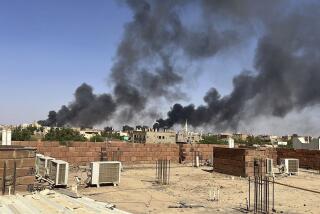Canadians Scour Tora Bora Area; No Sign of Bin Laden
- Share via
BAGRAM AIR BASE, Afghanistan — Canadian troops of the U.S.-led coalition against terrorism explored the caves and graves of the December battlefield in Tora Bora but returned Tuesday with little expectation of resolving the mystery of Osama bin Laden’s whereabouts.
The Canadian forces, backed by U.S. forensic experts, brought back DNA samples from 23 bodies found at a burial site believed to hold victims of the ferocious U.S. bombing during the campaign in the mountains east of Jalalabad.
“We did not find anybody who was 6 foot 5,” said Canadian Capt. Philip Nicholson, who directed the excavations at the end of a four-day sweep through the rugged terrain. Pentagon officials thought that Bin Laden, who is well over 6 feet tall, was directing the resistance of his loyalists in December from a hide-out in the region, but a search of caves at the time produced no evidence of the exiled Saudi or his top lieutenants.
Evidence of Shrine
During their conduct of Operation Torii, one of a number of searches being carried out in volatile eastern Afghanistan, soldiers found evidence of a shrine to Islamic martyrs at Tora Bora.
U.S. forensic experts from the Army criminal investigation department assisted the Canadians in collecting the DNA samples. The coalition hopes to identify some of those buried in the Tora Bora grave, said Maj. Bryan Hilferty, spokesman for the U.S. forces at Bagram. But he insisted that the objective of Operation Torii was to rid the Al Qaeda terrorist network’s mountain redoubt of any usable shelter or supplies that might aid future guerrilla operations.
“We were not looking for Bin Laden or a rotund little one-eyed man either,” Hilferty said, referring to Taliban leader Mullah Mohammed Omar. “That was not the point of the mission.”
The 400 Canadian troops who took part in Operation Torii returned here early Tuesday looking grubby and beleaguered, although a spokesman for their unit insisted that morale was high and that they felt the mission was a success, despite their having encountered neither Taliban nor Al Qaeda forces.
“Our mission was to conduct sensitive site exploitation and to destroy underground facilities in mountainous eastern Afghanistan, in order to deny Al Qaeda access to the area,” Canadian navy Lt. Luc Charron told reporters.
While in the area, troops discovered a warren of caves that had survived the December barrage except for a cave-in at the entrance. Charron said the site was blown up and sealed to prevent access.
In the absence of recent sightings of Bin Laden, accused by U.S. officials of masterminding the Sept. 11 attacks, some observers have speculated that he was killed during the intense bombardment in December. Others believe that he and his lieutenants escaped across the border to Pakistan.
In another area of eastern Afghanistan, which coalition officers have declined to specify for security reasons, 1,000 troops have been combing two facing mountain ranges and the valley between in search of ammunition, food caches and other supplies that the suspected terrorists might have left behind for future use.
The British-led mission, known as Operation Snipe, is being conducted in an area next to the March battlefield at Shahi Kot. U.S. Special Forces clashed with Al Qaeda and Taliban troops in that fight, leaving hundreds of the suspected terrorists and eight U.S. soldiers dead.
As of Tuesday, no enemy forces had been encountered yet in that mission, which British Royal Marines spokesman Lt. Col. Paul Harradine said was moving into a new phase after participants had spent more than a week scaling the highest territory to conduct a top-down search for holdouts.
U.S. Forces in Pakistan
U.S. Special Forces also have deployed to lawless tribal areas of Pakistan, just across the border from the regions now being searched by the British, apparently in hopes of blocking the escape routes used by Al Qaeda and the Taliban.
A Pakistani security team flew to Washington on Monday to work with U.S. allies on a plan to tighten the 870-mile border cutting through ethnic communities that straddle the Afghan-Pakistani divide.
Taliban fighters also enjoy some local support in the rebellious southeastern areas of this country, particularly in Paktia and Khowst provinces, where warlords struggling to maintain their control over traditional fiefdoms have rejected the authority of the interim Afghan government headed by Prime Minister Hamid Karzai.
More to Read
Sign up for Essential California
The most important California stories and recommendations in your inbox every morning.
You may occasionally receive promotional content from the Los Angeles Times.














